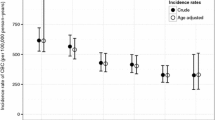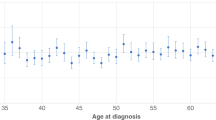Summary
Tissue from contralateral breast was taken from 505 patients with invasive breast cancer. Every 5th patient had simultaneous carcinom in the opposite breast, 7.7% (39/505) had invasive cancer, and 13.1% (66/505) had carcinoma in situ.
Invasive cancers in the opposite breast were diagnosed at an earlier stage as compared with the neoplasm of the primary breast. However, 26% of the patients already had positive axillary nodes. The following risk indicators of the bilateral disease were found: age at time of diagnosis, histologic type of tumours, familial breast cancer, suspicious mammography, P2/DY-breast parenchymal pattern (Wolfe) and multicentric cancer of primary breast. Our findings support the proposal to consider bilaterality of breast cancer as a sign of systemic disease of the breasts, involving the ductal and lobular system within eight quadrants of a paired organ (Ober).
Similar content being viewed by others
References
Beahrs OH, Shapiro S, Smart C (1979) Report of the working group to review the national cancer institute — American cancer society. Breast cancer detection demonstration projects. J Nat Cancer Inst 62:640–709
Chaudary MA, Millis RR, Hoskins EOL, Halder M, Bulbrook RD, Cuzick J, Hayward JL (1984) Bilateral primary breast cancer: a prospective study of disease incidence. Br J Surg 71:711–714
Fisher ER, Fisher B, Sass R, Wickerham L et al. (1984) Pathologic findings from the national surgical adjuvant breast project (Protocol No. 4). Cancer 54: 3002–3011
Leis HP (1980) Managing the remaining breast. Cancer 46:1026–1030
Lesser ML, Rosen PP, Kinne DW (1982) Multicentricity and bilaterality in invasive breast carcinoma. Surgery 91:234–240
Ober KG (1982) The opposite breast — a model that may help us to understand breast cancer. Clinics Oncol 1:401–410
Rosen PP, Senie R, Schottenfeld D, Ashikari R (1979) Noninvasive breast carcinoma. Frequency of unsuspected invasion and implications for treatment. Ann Surg 189:377–382
Tulusan AH, Egger H, Schneider ML, Willgeroth F (1982) A contribution to the natural history of breast cancer. IV. Lobular carcinoma in situ and its relation to breast cancer. Arch Gynecol 231:219–226
Urban JA (1970) Bilateral breast cancer. Breast cancer: early and late. Year Book Medical Publ Inc, Chicago, pp 262–270
Urban JA, Papachristou D, Taylor J (1977) Bilateral breast cancer — biopsy of the opposite breast. Cancer 40:1968–1973
Urban JA (1985) Bilateral breast cancer revealed by biopsy of the opposite breast. In: Zander J, Baltzer J (eds) Early breast cancer. Springer, Berlin Heidelberg New York Tokyo, pp 33–38
Veronesi U, Zucali R, Luini A, Belli F, Crispino S, Merson M (1985) Conservative treatment of breast cancer with the “QU.A.RT.” Technique. In: Zander J, Baltzer J (eds) Early breast cancer. Springer, Berlin Heidelberg New York Tokyo, pp 264–270
Author information
Authors and Affiliations
Additional information
Dedicated to Prof. Dr. K. G. Ober on his 70th birthday. His personal support and professional acumen has made this investigation possible
Rights and permissions
About this article
Cite this article
Tulusan, A.H., Ronay, G., Egger, H. et al. A contribution to the natural history of breast cancer. Arch. Gynecol. 237, 85–91 (1985). https://doi.org/10.1007/BF02199712
Received:
Issue Date:
DOI: https://doi.org/10.1007/BF02199712




